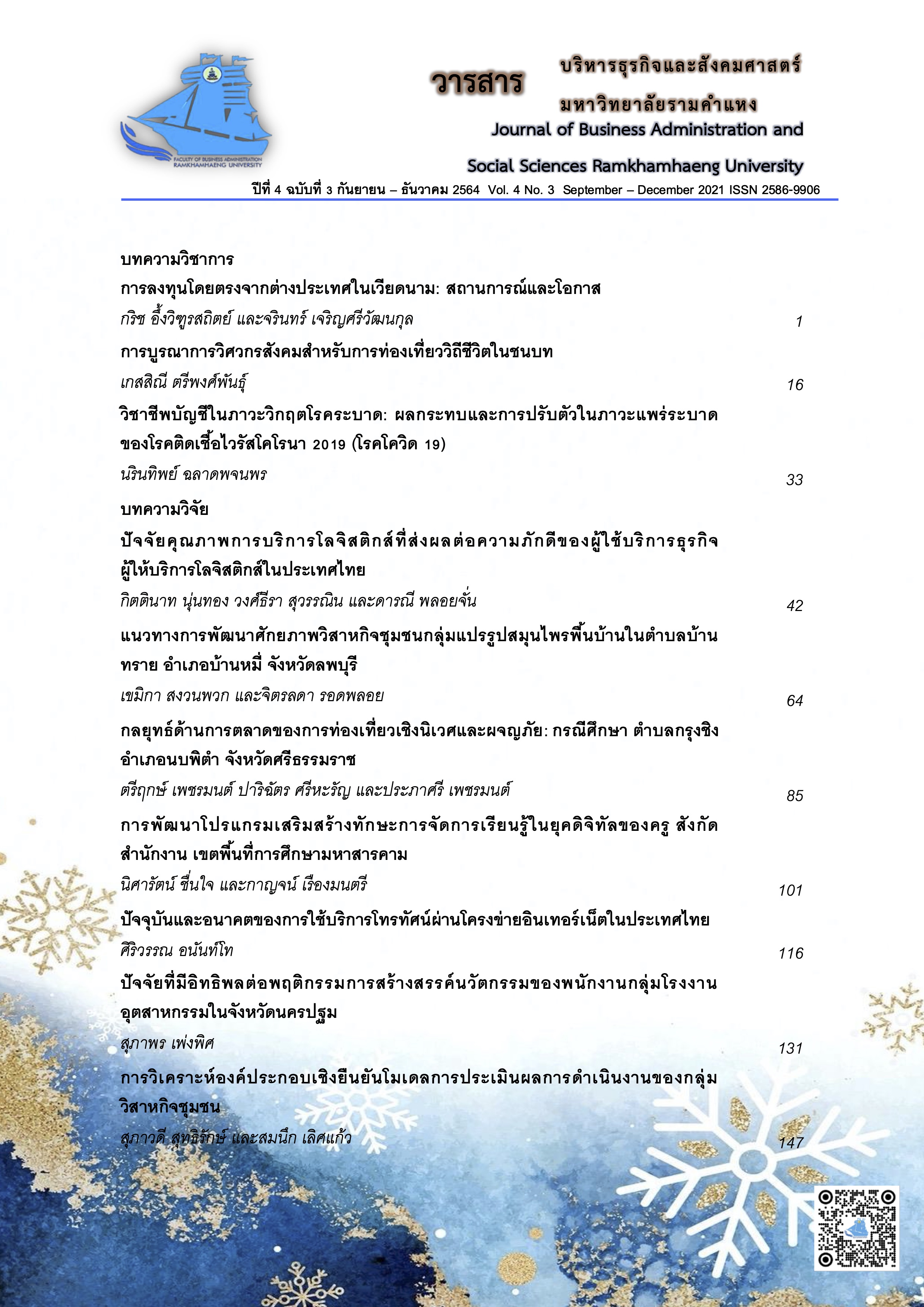Confirmatory Factor Analysis of a Performance Evaluation Model of Community Enterprises
Main Article Content
Abstract
In this research investigation, the researchers conduct (1) a second-order confirmatory factor analysis of a performance evaluation model of community enterprises in Surat Thani province; and test (2) the congruence of the performance evaluation model of the enterprises under study and the empirical data. The sample population consisted of 390 community enterprises in Surat Thani province using the techniques of stratified and purposive sampling. Data were collected from the executives of community enterprises. The performance evaluation model of the community enterprises under study was analyzed using the technique of second-order confirmatory factor analysis.
The four-component confirmatory factor analysis of the performance evaluation model of community enterprises in Surat Thani province found the following. The component weight in the second-order confirmatory factor analysis at the statistically significant level of 0.01 exhibited the component weight in the following descending order: (1) internal process; (2) learning and growth; (3) customers; and (4) finance with the values of 0.968, 0.884, 0.851, and 0.774. The performance evaluation model of community enterprises exhibited congruence with the empirical data and could be used in the evaluation of the performance of community enterprises
Article Details
เนื้อหาและข้อมูลในบทความที่ลงตีพิมพ์ในวารสารบริหารธุรกิจและสังคมศาสตร์ มหาวิทยาลัยรามคำแหง ถือเป็นข้อคิดเห็นและความรับผิดชอบของผู้เขียนบทความโดยตรง ซึ่งกองบรรณาธิการไม่จำเป็นต้องเห็นด้วย หรือร่วมรับผิดชอบใดๆ
บทความ ข้อมูล เนื้อหา รูปภาพ ฯลฯ ที่ได้รับการตีพิมพ์ในวารสารบริหารธุรกิจและสังคมศาสตร์ มหาวิทยาลัยรามคำแหง ถือเป็นลิขสิทธิ์ของวารสารบริหารธุรกิจและสังคมศาสตร์ มหาวิทยาลัยรามคำแหง หากบุคคลหรือหน่วยงานใดต้องการนำบทความทั้งหมดหรือส่วนหนึ่งส่วนใดไปเผยแพร่ต่อ หรือเพื่อกระทำการใดๆ จะต้องได้รับอนุญาตเป็นลายลักษณ์อักษรจากวารสารบริหารธุรกิจและสังคมศาสตร์ มหาวิทยาลัยรามคำแหง ก่อนเท่านั้น
References
กรกฎ สระคูพันธ์ แล ศุภวัฒนากร วงศ์ธนวสุ. (2562). การศึกษาการบริหารจัดการวิสาหกิจชุมชนกลุ่มแปรรูปแป้งจากข้าวหอมมะลิ: กรณีศึกษาจังหวัดร้อยเอ็ด. วารสารบัณฑิตศึกษา, 16(74), 76–82
กองส่งเสริมวิสาหกิจชุมชน. กรมส่งเสริมการเกษตร. (2563). สรุปจำนวนวิสาหกิจชุมชนและเครือข่ายวิสาหกิจชุมชนที่อนุมัติการจดทะเบียนแล้วจำแนกตามประเภทกิจการ จังหวัดสุราษฎร์ธานี. สืบค้นจาก http://smce.doae.go.th/smce1/report/report_smce_activity.php
เจณิภา คงอิ่ม. (2561). การจัดการด้านการตลาดและผลการดำเนินงานของ SMEs ในจังหวัดนนทบุรี. วารสารมนุษยศาสตร์และสังคมศาสตร์ มหาวิทยาลัยราชพฤกษ์, 4(2), 77–92.
ดุษฎี นาคเรือง, สุธิดา วัฒนยืนยง, และนุชนภา เลขาวิจิตร์. (2560). ปัจจัยที่มีอิทธิพลต่อผลการดำเนินงานของวิสาหกิจชุมชนจังหวัดยะลา. วารสารศรีนครินทรวิโรฒวิจัยและพัฒนา (สาขามนุษยศาสตร์และสังคมศาสตร์), 9(17), 69–77.
ทักษญา สง่าโยธิน. (2560). ปัจจัยที่ส่งผลต่อความสำเร็จของการดำเนินงานวิสาหกิจชุมชน. วารสารวิทยาลัยพาณิชยศาสตร์บูรพาปริทัศน์, 12(2), 11–25.
ธีรฉัตร เทียมทอง และเพ็ญณี แนรอท. (2561). แนวทางการพัฒนาวิสาหกิจชุมชนที่ยั่งยืน กรณีศึกษาวิสาหกิจชุมชนกลุ่มเลี้ยงปลากระชังแม่น้ำโขง บ้านพร้าวใต้ ตำบลหินโงม อำเภอเมืองหนองคาย
จังหวัดหนองคาย. วารสารการบริหารปกครอง, 7(2), 245–265.
ปนัดดา โพธินาม. (2560). การศึกษาและพัฒนาการบริหารจัดการกลุ่มวิสาหกิจชุมชน จังหวัดกาฬสินธุ์. วารสารวิถีสังคมมนุษย์, 5(1), 191–206.
ภัทรธิดา วัฒนาพรรณกิตติ. (2559). ปัจจัยที่มีผลต่อความสําเร็จของวิสาหกิจชุมชนระดับ 5 ดาว จังหวัดลําปาง. วารสารการวิจัยกาสะลองคำ, 10(2), 17–26.
ลักขณา อินทร์บึง, อารดา ชัยเสนา, และรัชดา ภักดียิ่ง. (2563) ปัจจัยแห่งความสำเร็จของกลุ่มวิสาหกิจชุมชนที่ได้รับรองมาตรฐานผลิตภัณฑ์ชุมชน จังหวัดขอนแก่น. Journal of Roi Kaensarn Academi, 5(2), 1–12.
วรลักษณ์ ลลิตศศิวิมล. (2561). วิเคราะห์องค์ประกอบเชิงยืนยันความสำเร็จในการดำเนินงานของธุรกิจเอกชน. วารสารมนุษยศาสตร์และสังคมศาสตร์ มหาวิทยาลัยมหาสารคาม, 37(1), 130–140.
พระราชบัญญัติส่งเสริมวิสาหกิจชุมชน พ.ศ. 2548. (2548, 8 มกราคม). ราชกิจจานุเบกษา. เล่มที่ 122 ตอนที่ 6 ก, หน้า 1-13.
สุดารัตน์ แช่มเงิน, ประเดิม ฉ่ำใจ, และพัชราวดี ศรีบุญเรือง. (2560). ปัจจัยที่มีผลต่อความสำเร็จของวิสาหกิจชุมชนไวน์ศรีชุมแสง ตำบลท่าไม้รวก อำเภอท่ายาง จังหวัดเพชรบุรี. วารสารเกษตรพระจอมเกล้า, 35(3), 127–136.
อนุรัตน์ อนันทนาธร. (2562). รายงานการวิจัยฉบับสมบูรณ์ โครงการการจัดการความมั่นคงของวิสาหกิจชุมชนตามแนวคิดปรัชญาเศรษฐกิจพอเพียง. โครงการวิจัยประเภทงบประมาณเงินรายได้
(เงินอุดหนุนจากรัฐบาล) ประจำปีงบประมาณ พ.ศ. 2562, มหาวิทยาลัยบูรพา.
Camilleri, M. (2017). Corporate sustainability and responsibility: creating value for business, society and the environment. Asian Journal of Sustainability and Social Responsibility, 2(1), 59-74.
Eltahir, O. A. B. (2019). Factors affecting the performance & business success of small & medium enterprises in Sudan (case study: Omdurman). International Journal of Small Business and Entrepreneurship Research, 6(6), 14–22.
Kaplan, R. S. & Norton, D. P. (1992). The Balanced Scorecard – Measures That Drive Performance. Harvard Business Review, 70(1), 71-79.
Hair, J. F. Jr., Black, W. C., Babin, B. J. & Anderson, R. E. (2014). Multivariate Data Analysis (7th ed.). New Jersey: Pearson Education Limited.
Liao, S. H., Chen, C. C., Hu, D. C., Chung, Y. C., & Liu, C. L. (2017). Assessing the influence of leadership style, organizational learning and organizational innovation. Leadership & Organization Development Journal, 38(5), 590-609.
Malagueño, R., Lopez-Valeiras, E., & Gomez-Conde, J. (2018). Balanced scorecard in SMEs: effects on innovation and financial performance. Small Business Economics, 51(1), 221–244.
Nielsen, S., & Nielsen, E. H. (2015). The Balanced Scorecard and the Strategic Learning Process: A System Dynamics Modeling Approach. Advances in Decision Sciences, Article ID 213758, 1–20.
Niven, P. R. (2003). Balanced scorecard step-by-step for government and nonprofit agencies. Hoboken New Jersey: John Wiley & Sons.
Surin, E. F., Edward, O. T., Hussin, M. H. F., & Wahab, I. A. (2017). Recognizing the importance of strategic business network on business performance of SME manufacturing firms in Malaysia: analyzing the moderating influence of human capital and business environment. International Journal of Arts & Sciences, 9(4), 31–44.

